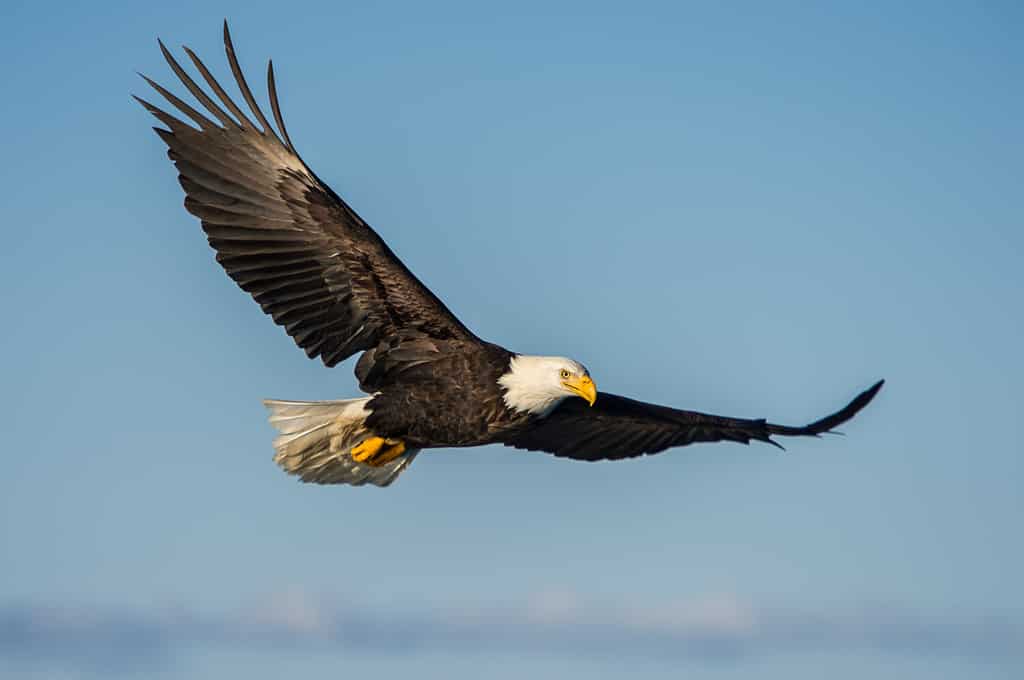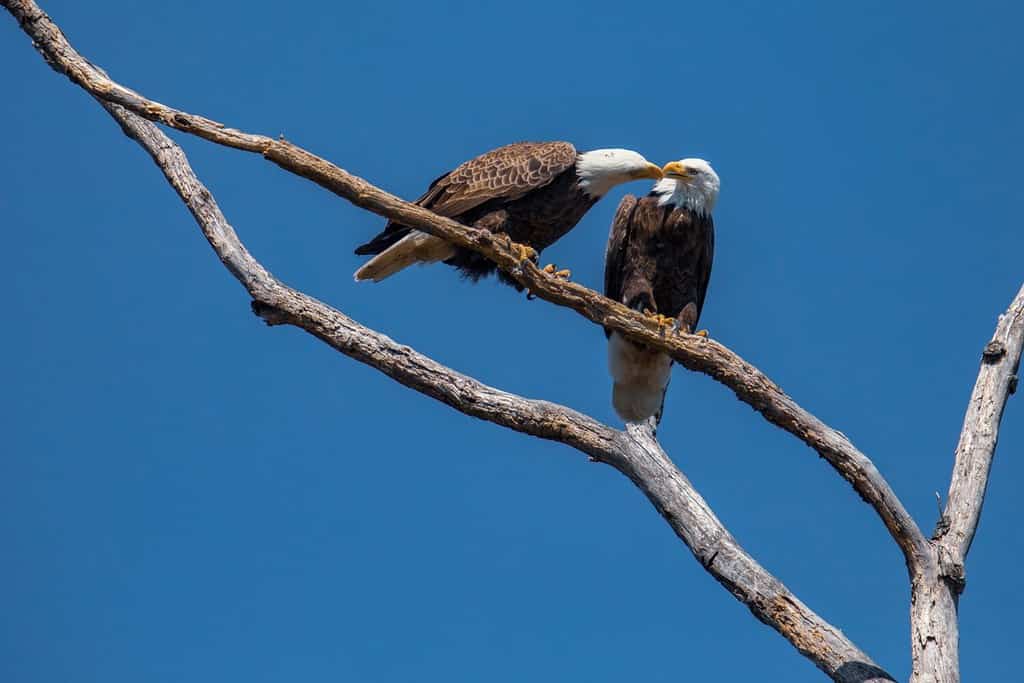Bald eagles in Louisiana represent not only the resilience of a species but also embody the spirit of American heritage. As their numbers continue to rebound through dedicated conservation efforts, the presence of these regal birds serves as a reminder of the importance of protecting and preserving our natural world. Whether you’re a devoted birdwatcher or simply someone who appreciates the beauty of nature, the bald eagles of Louisiana offer a truly awe-inspiring sight that should not be missed. So, grab your binoculars and embark on a journey to witness the splendor of these magnificent creatures in the Bayou State. Let’s explore the best places and times to see Bald Eagles in Louisiana!
Top 3 Places to See Bald Eagles in Louisiana

There are various places bald eagles can be spotted in the state of Louisiana.
©PHOTOOBJECT/Shutterstock.com
1. Louisiana Swamps:
A swamp is a wetland characterized by the presence of waterlogged soils, dense vegetation, and slow-moving or stagnant water. It is typically found in low-lying areas and is home to a diverse range of plant and animal species. Swamps are essential ecosystems that provide numerous benefits, including flood control, water filtration, and habitat for various wildlife.
Louisiana’s swamps are renowned for their rich biodiversity and serve as prime habitats for bald eagles. These majestic birds are attracted to swamps due to the abundance of prey, such as fish and small mammals, found in the water and surrounding vegetation. The ample tree cover in the swamps provides suitable nesting sites for bald eagles, ensuring their breeding success.
Moreover, the slow-moving waters of swamps offer optimal conditions for bald eagles to hunt and fish. The peace and seclusion provided by the swamps allow these magnificent creatures to thrive and provide an excellent opportunity for nature enthusiasts to observe and appreciate the beauty of bald eagles in their natural habitat.
Here are 3 swamps in Louisiana where you can spot Bald Eagles:
The Atchafalaya Swamp:
Located in south-central Louisiana, the Atchafalaya Swamp is one of the best swamps in the state to see bald eagles. This vast and dense swamp is known for its meandering waterways, cypress trees, and diverse wildlife.
The Maurepas Swamp:
Situated near Baton Rouge, the Maurepas Swamp offers a unique habitat for bald eagles. With its extensive wetlands, cypress-tupelo forests, and open water areas, this swamp provides an ideal environment for eagles to hunt and nest.
The Barataria Preserve:
Located in southeastern Louisiana, the Barataria Preserve is a part of the Jean Lafitte National Historical Park and Preserve. This swamp is characterized by its marshy areas, bayous, and freshwater lagoons, making it an attractive location for bald eagles.
2. Louisiana Bayous:
Bayous, although similar to swamps, are not the same. However, both prove to be excellent habitats for Bald Eagles. A bayou is a slow-moving, marshy, or swampy waterway typically found in the southern United States, particularly in Louisiana. It is characterized by its meandering path, lined with dense vegetation, and often serves as a natural drainage system for nearby rivers and lakes. Bayous are essential components of Louisiana’s unique ecosystem, providing habitat for a diverse range of wildlife.
Bayous in Louisiana are excellent spots to see bald eagles due to several factors. Firstly, the bayous offers an abundance of food sources for bald eagles, including fish, reptiles, and small mammals. The slow-moving waters provide ideal hunting grounds for these majestic birds of prey.
Secondly, the dense vegetation along the bayous provides ample cover and nesting sites for bald eagles. These birds prefer tall trees near water bodies to build their nests, and bayous offer plenty of suitable locations for breeding and raising their young.
Lastly, the tranquil and secluded nature of the bayous creates a peaceful environment for bald eagles to thrive and attracts them to these areas. This makes the Bayous in Louisiana a prime destination for birdwatchers and nature enthusiasts to witness the awe-inspiring sight of bald eagles in their natural habitat.
Here are 3 bayous in Louisiana known to be a habitat for Bald Eagles:
Bayou Teche:
Stretching over 125 miles from Port Barre to Morgan City, Bayou Teche is known for its scenic beauty and rich wildlife. Its tranquil waters, cypress trees, and marshy areas make it a favored spot for bald eagles to roost and hunt.
Bayou Sauvage National Wildlife Refuge:
Located just outside New Orleans, Bayou Sauvage is the largest urban wildlife refuge in the United States. This bayou is home to a diverse range of habitats, including marshes, swamps, and lakes, providing ample opportunities to spot bald eagles.
Bayou D’Arbonne:
Situated in northern Louisiana, Bayou D’Arbonne is a popular fishing and recreational destination. Its expansive waterways, cypress trees, and abundance of fish make it an attractive area for bald eagles to frequent.
3. Designated Bird Areas or Wildlife Refuges:
A designated bird area or wildlife refuge is a specific location that has been set aside and managed to protect and preserve the natural habitat and species within it, particularly birds and other wildlife. These areas are carefully selected based on their ecological significance and are often home to diverse populations of birds, including the iconic bald eagle.
In Louisiana, designated bird areas and wildlife refuges provide ideal conditions for bald eagles due to several reasons. First, these areas offer a variety of ecosystems such as wetlands, forests, and water bodies, which provide the necessary resources and habitat for bald eagles to thrive. Second, these areas are typically undisturbed and provide a safe haven for nesting, breeding, and foraging activities. Third, wildlife refuges and designated bird areas often implement conservation measures to protect the natural surroundings, ensuring a healthy and sustainable environment for bald eagles and other bird species.
These protected areas also attract a diverse range of bird species, creating an enriched ecosystem that supports the food chain and fosters biodiversity. As a result, birdwatchers and nature enthusiasts have a higher chance of spotting bald eagles in these designated areas, making them excellent spots to witness the majestic presence of these iconic birds.
Here are 3 designated bird areas or wildlife refugees in Louisiana known to have Bald Eagles:
Catahoula Lake:
Located in central Louisiana, Catahoula Lake is a designated Important Bird Area and a significant wintering ground for bald eagles. Its shallow water and marshy habitats provide a rich food source for eagles during the winter months.
Sabine National Wildlife Refuge:
Situated in southwestern Louisiana, the Sabine National Wildlife Refuge is a vital stopover for migratory birds, including bald eagles. Its diverse habitats, including marshes, prairies, and forests, attract a wide range of bird species.
Cameron Prairie National Wildlife Refuge:
Located along the Gulf Coast, the Cameron Prairie National Wildlife Refuge is known for its vast wetlands, freshwater marshes, and coastal prairies. These habitats provide an ideal setting for bald eagles, especially during the winter months.
While there may not be specific guided tours or wildlife reserves solely dedicated to bald eagle viewing, these areas offer opportunities for birdwatching and wildlife observation. Visitors can explore the swamps, bayous, and designated bird areas in Louisiana, keeping an eye out for bald eagles in their natural habitats.
Best Times to See Bald Eagles in Louisiana:

Bald eagles can be spotted at various times throughout the year in Louisiana, but winter is best.
©FloridaStock/Shutterstock.com
Bald eagles can be spotted in Louisiana throughout the year, but there are certain times and locations that offer better opportunities for sightings.
Seasonal Patterns And Migratory Behavior:
Bald eagles in Louisiana exhibit seasonal patterns and migratory behavior. During the winter months, from November to February, bald eagles from northern regions migrate south to Louisiana in search of milder climates and abundant food sources. This period is considered prime for eagle sightings.
Therefore, to maximize your chances of seeing bald eagles in Louisiana, it is recommended to visit the swamps, bayous, and wildlife refuges during the winter months, particularly in December and January. These months coincide with the peak of their winter migration and offer increased chances of observing these magnificent birds in action.
Annual Events And Festivals:
Keep an eye out for local events and festivals that celebrate bald eagle sightings, as they can provide unique opportunities to observe and learn about these remarkable birds. For example, the Eagle Expo in Morgan City, held in February, showcases the abundance of bald eagles in the area and offers guided tours and educational programs for bird enthusiasts.
Tips for Observing Bald Eagles in Louisiana

There are certain tips you can follow to ensure you spot bald eagles when birdwatching in Louisiana.
©EleanorAbramson/Shutterstock.com
To help you make the most of your bald eagle viewing experience, here are some tips to ensure a respectful and enjoyable encounter.
Respecting the Birds’ Natural Habitat:
One of the most important aspects of observing bald eagles is to respect their natural habitat and avoid disturbing them. These tips will help you minimize your impact on their environment:
- Keep a Safe Distance: Maintain a respectful distance from the eagles and their nests, typically at least 200 yards away, to avoid causing unnecessary stress or disturbance to the birds.
- Stay Quiet and Still: Keep noise levels to a minimum and move slowly and quietly to avoid startling the eagles. Sudden movements or loud noises can disrupt their natural behavior and cause them to fly away.
- Follow Restricted Areas: Be aware of any restricted areas or nesting sites in the vicinity and adhere to guidelines or regulations put in place to protect the eagles and their habitat.
Optimal Viewing Equipment:
Having the right equipment can significantly enhance your bald eagle observing experience. Here are some recommendations for binoculars, cameras, and other essential equipment:
- Binoculars: Invest in a pair of high-quality binoculars with a magnification power of at least 8x or 10x to get a closer look at the eagles’ intricate features and behaviors. Look for models that are lightweight and provide a wide field of view for comfortable and immersive viewing.
- Cameras: If you wish to capture breathtaking photographs of bald eagles, consider using a DSLR or mirrorless camera with a telephoto lens. A lens with a focal length of 300mm or longer will allow you to capture detailed close-ups from a safe distance.
- Tripod: To steady your camera and ensure sharp images, use a sturdy tripod. This will also help reduce fatigue during prolonged observation sessions.
- Field Guide or Birding App: Carry a field guide or use a birding app on your smartphone to help identify different species of birds, including the bald eagle. These resources can provide valuable information on their behavior, habitat, and distinctive features.
In Conclusion:
Observing bald eagles in Louisiana can be a rewarding and awe-inspiring experience. By respecting their natural habitat, maintaining a safe distance, and using appropriate equipment, you can enjoy their presence without causing harm or disturbance. Remember, the well-being of these magnificent creatures should always take precedence. This will allow them to thrive in their environment for generations to come. Happy birdwatching!
The photo featured at the top of this post is © Kevin Tubbergen/Shutterstock.com
Thank you for reading! Have some feedback for us? Contact the AZ Animals editorial team.







